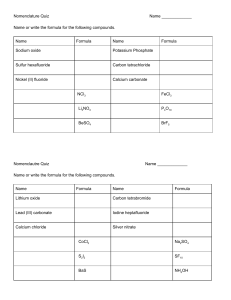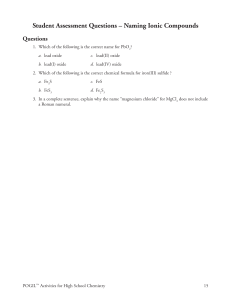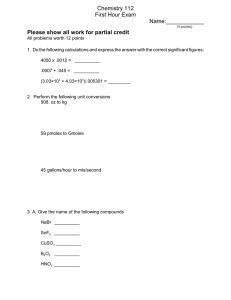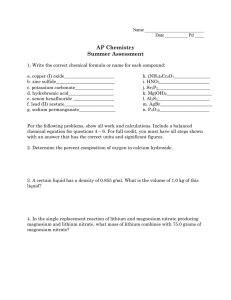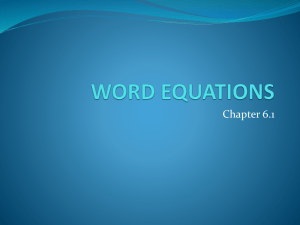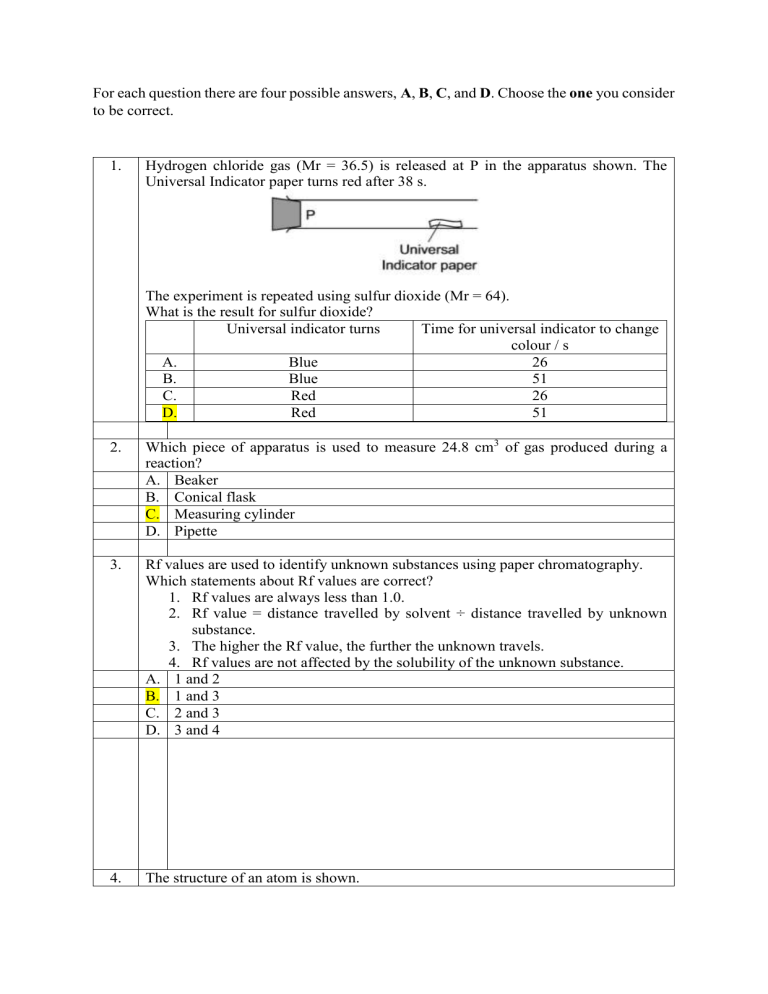
For each question there are four possible answers, A, B, C, and D. Choose the one you consider to be correct. 1. Hydrogen chloride gas (Mr = 36.5) is released at P in the apparatus shown. The Universal Indicator paper turns red after 38 s. The experiment is repeated using sulfur dioxide (Mr = 64). What is the result for sulfur dioxide? Universal indicator turns Time for universal indicator to change colour / s A. Blue 26 B. Blue 51 C. Red 26 D. Red 51 2. Which piece of apparatus is used to measure 24.8 cm3 of gas produced during a reaction? A. Beaker B. Conical flask C. Measuring cylinder D. Pipette 3. Rf values are used to identify unknown substances using paper chromatography. Which statements about Rf values are correct? 1. Rf values are always less than 1.0. 2. Rf value = distance travelled by solvent ÷ distance travelled by unknown substance. 3. The higher the Rf value, the further the unknown travels. 4. Rf values are not affected by the solubility of the unknown substance. A. 1 and 2 B. 1 and 3 C. 2 and 3 D. 3 and 4 4. The structure of an atom is shown. Which element is the atom an isotope of? A. Nitrogen B. Oxygen C. Phosphorus D. Titanium 5. Which row describes the formation of single covalent bonds in methane? A. Atoms share a pair of electrons Both atoms gain a noble gas electronic structure B. Atom share a pair of electrons Both atoms have the same number of electrons in their outer shell C. Electrons are transferred from Both atoms gain a noble gas electronic one atom to another structure D. Electrons are transferred from Both atoms have the same number of one atom to another electrons in their outer shell 6. Which statement describes the structure of an ionic compound? A. It is a giant lattice of oppositely charged ions B. It is a giant lattice of positive ions in a sea of electrons C. It is a giant molecule of oppositely charged ions D. It is a simple molecule of oppositely charged ions 7. Propane burns in oxygen. C3H8 + xO2 → 3CO2 + yH2O Which values of x and y balance the equation? x A. 5 B. 7 C. 10 D. 13 8. Y 4 4 8 8 A tablet contains 0.080 grams of ascorbic acid (Mr = 176). What is the concentration of ascorbic acid when one tablet is dissolved in 200 cm3 of water? A. 9.1 × 10-5 mol/dm3 B. 4.5 × 10-4 mol/dm3 C. 9.1 × 10-2 mol/dm3 D. 2.3 × 10-3 mol/dm3 9. Which statement about the electrolysis of copper (II) sulfate solution using carbon electrode is correct? A. A colourless gas is produced at the anode B. A colourless gas is produced at the cathode C. The colour of the electrolyte remains the same D. The mass of both electrodes remains constant 10. Aluminium metal is extracted from aluminium oxide by electrolysis. Which ionic half equation describes a reaction that occurs at the named electrode? Ionic half-equation Electrode 2A. Anode 2O → O2 + 2e B. Cathode Al3+ + 3e- → Al C. Cathode 2O2- → O2 + 4e3+ D. Cathode Al + 3e → Al 11. Fuel cells are used as energy sources in cars. Which row gives a fuel used in a fuel cell and the products formed? Fuel in a fuel cell Products formed A. Hydrogen Carbon dioxide and water B. Hydrogen Water only C. Petrol Carbon dioxide and water D. Petrol Water only 12. Two elements, X and Y, react together to form a covalent molecule as shown. The reaction is exothermic. X2(g) + Y2(g) → 2XY(g) The bond energies are shown in the table. Bond X-X Y-Y X-Y Bond energy in kJ/mol 436 242 431 What is the energy change for the reaction? A. +184 kJ/mol B. -184 kJ/mol C. +247 kJ/mol D. -247 kJ/mol 13. Which change in reaction conditions increases both the collision rate and the proportion of molecules with sufficient energy to react? A. Addition of a catalyst B. Increasing the concentration of a reactant C. Increasing the surface area of a reactant D. Increasing the temperature of the reaction 14. When blue-green crystals of nickel (II) sulfate are heated, water is produced and yellow solid remains. When water is added to the yellow solid, the blu-green colour returns. Which process describes these changes? A. Combustion B. Corrosion C. Neutralisation D. Reversible reaction 15. Methanol is prepared by the reversible reaction shown. CO(g) + 2H2(g) ⇌ CH3OH(g) The forward reaction is exothermic. Which conditions produce the highest equilibrium yield of methanol? Temperature Pressure A. High High B. High Low C. Low Low D. Low Low 16. The thermite reaction can be used to produce iron from iron (III) oxide. The equation for the reaction is shown. 2Al + Fe2O3 → 2Fe + Al2O3 Which statements about this reaction are correct? 1. Aluminium is the oxidizing agent 2. Aluminium is less reactive than iron 3. Electrons are transferred from aluminium to iron The iron in the iron (III) oxide is reduced A. 1 and 3 B. 1 and 4 C. 2 and 3 D. 3 and 4 17. In which row are the oxides correctly identified? Acidic Basic A. Magnesium oxide, calcium Sulfur oxide, carbon dioxide oxide B. Magnesium oxide, sulfur Carbon dioxide, calcium oxide dioxide C. Sulfur dioxide, carbon dioxide Calcium oxide, magnesium oxide D. Sulfur dioxide, magnesium Calcium oxide, carbon dioxide oxide 18. Aqueous sodium hydroxide is added to solid Q in a test tube. A gas is produced which turns damp red litmus blue. What is Q? A. Aluminium B. Ammonia C. Ammonium chloride D. Sodium nitrate 19. Potassium hydroxide is a base. Which statement describes a reaction of a potassium hydroxide? A. Chlorine is formed when it is heated with ammonium chloride B. It turns universal indicator green C. It reacts with an acid to produce a salt and water D. It turns methyl orange red 20. Some general rules for the solubility of salts in water are listed. Carbonates are insoluble (except ammonium carbonate, potassium carbonate, and sodium carbonate) Chlorides are soluble (except lead (II) chloride and silver chloride) Nitrates are soluble Sulfates are soluble (except barium sulfate, calcium sulfate, and lead (II) sulfate) Which substances produce an insoluble salt when aqueous solutions of them are mixed? A. Barium chloride and magnesium nitrate B. Calcium chloride and ammonium nitrate C. Silver nitrate and zinc chloride D. Sodium carbonate and potassium sulfate 21. Elements in Group I of the Periodic Table react with water. Which row describes the products made in the reaction and the trend in reactivity of the elements? Products Trend in reactivity A. Metal hydroxide and water Less reactive down the group B. Metal hydroxide and water More reactive down the group C. Metal oxide and hydrogen Less reactive down the group D. Metal oxide and hydrogen More reactive down the group 22. Which statement about the halogens is correct? A. A sample of bromine reacts with potassium chloride solution B. A sample of bromine reacts with potassium iodide solution C. A sample of chlorine has a higher density than a sample of bromine D. A sample of chlorine is a darker colour than a sample of bromine 23. Which row describes the properties of a transition element? Property 1 Property 2 A. Forms colourless compounds Acts as a catalyst B. Form colourless compounds Low electrical conductivity C. High density Acts as a catalyst D. High density Low electrical conductivity 24. Zinc is extracted from its ore, zinc blende, using two chemical reactions. 1. 2ZnS + 3O2 → 2ZnO + 2SO2 2. 2ZnO + C → 2Zn + CO2 Which substance is reduced in reactions 1 and 2? Reaction 1 O2 O2 ZnS ZnS A. B. C. D. 25. Reaction 2 C ZnO C ZnO Four metals, zinc, M, copper and magnesium, are reacted with aqueous solutions of their nitrates. The results are shown. Metal Magnesium M nitrate Copper nitrate Zinc nitrate nitrate √ √ √ Magnesium √ √ Zinc × M Copper × × √ × × × Key × = no reaction √ = reacts What is the order of reactivity of these four metals starting with the most reactive? A. Copper → zinc → M → magnesium B. Copper → M → zinc → magnesium C. Magnesium → M → zinc → copper D. Magnesium → zinc → M → copper 26. Why is aluminium used to make containers for storing food? A. It conducts electricity B. It has a high melting point C. It is resistant to corrosion D. It is strong 27. Water can be treated by filtration then chlorination. Which uses do not need water of this quality? 1. water for cooling in industry 2. water for washing clothes 3. water for drinking A. 1, 2, and 3 B. 1 and 2 only C. 1 and 3 only D. 2 and 3 only 28. Ammonia is manufactured by the Haber Process. N2(g) + 3H2(g) ⇌ 2NH3(g) The forward reaction is exothermic. Which conditions maximise the yield of ammonia? A. B. C. D. 29. Pressure High High Low Low Temperature High Low High Low The carbon cycle is shown. Which row describes processes X, Y, and Z? X Y A. Respiration Combustion B. Respiration Photosynthesis C. Photosynthesis Combustion D. Photosynthesis Respiration Z Photosynthesis Combustion Respiration Combustion 30. Which row shows the conditions used in the contact process? Temperature / °C Pressure / atm Catalyst A. 25 2 Iron B. 25 200 Iron C. 450 2 Vanadium (V) oxide D. 450 200 Vanadium (V) oxide 31. Ethanol is produced by: 1. the catalytic addition of steam to ethene 2. fermentation. Which statement is correct? A. Both processes require similar amounts of energy B. Both processes use a catalyst C. Process 1 uses a renewable resource D. Process 2 produces the purest ethanol 32. The diagram represents a lime kiln used to heat limestone to a very high temperature. What leaves the kiln at X? A. Calcium carbonate B. Calcium hydroxide C. Calcium oxide D. Calcium sulfate 33. Which fuel could be gasoline? 34. Which statement about a homologous series is correct? A. All members have the same general formula B. All members have the same molecular formula C. All members have the similar physical properties D. Members show a trend in their chemical properties 35. Why is ethanol a member of the homologous series of alcohols but propane is not? A. Ethanol has two carbon atoms per molecule but propane has three B. Ethanol can be made from ethene but propane is obtained from petroleum C. Ethanol is a liquid but propane is a gas D. Ethanol contains the same functional group as other alcohols but propane does not 36. Chlorine reacts with methane. Which statements are correct? 1. The reaction takes place in the dark. 2. The reaction of chlorine with methane forms chloromethane. 3. Chloromethane reacts with chlorine to produce dichloromethane. 4. The reaction of chlorine with methane is an addition reaction. A. 1 and 2 B. 1 and 3 C. 2 and 3 D. 3 and 4 37. Increasing the number of atoms in one molecule of a hydrocarbon increases the amount of energy released when it burns. What is the correct order? Less energy released → more energy released A. Ethene Ethane Methane B. Ethene Methane Ethane C. Methane Ethane Ethene D. Methane Ethene Ethane 38. Which statements about aqueous ethanoic acid are correct? 1. Ethanoic acid contains the functional group –COOH 2. Ethanoic acid reacts with carbonates to produce hydrogen 3. Ethanoic acid turns Universal Indicator paper blue 4. Ethanoic acid has a pH lower than pH 7 A. 1 and 2 B. 1 and 3 C. 1 and 4 D. 2 and 4 39 The structure of an ester is shown. What is the name of the ester? A. Ethyl propanoate B. Methyl propanoate C. Propyl ethanoate D. Propyl methanoate 40. Alkanes undergo substitution reactions with chlorine in the presence of ultraviolet light. Which equation shows a reaction of this type? A. C3H6 + Cl2 → C3H6Cl2 B. C3H8 + Cl2 → C3H6Cl2 + H2 C. C3H8 + 2Cl2 → C3H8Cl2 + 2HCl D. C3H6 + Cl2 → C3H5Cl +HCl 41. The structure of a polymer is shown. Which type of polymer is shown and by which process is it formed? Type of polymer Formed by A. Carbohydrate Addition polymerisation B. Carbohydrate Condensation polymerisation C. Polyester Addition polymerisation D. Polyester Condensation polymerisation 42. Which statement about carbohydrates and proteins is correct? A. Carbohydrates and proteins are constituents of food B. Carbohydrates and proteins are natural polymers used to make larger molecules called monomers C. Carbohydrates and proteins are synthetic polymers D. Carbohydrates and proteins cause pollution as they are non-biodegradable 43. 2.00 g of powdered calcium carbonate is added to 50.0 cm3 of hydrochloric acid Which apparatus is used to measure the calcium carbonate and the hydrochloric acid? Calcium carbonate Hydrochloric acid A. Balance Burette B. Balance Thermometer C. Pipette Burette D. Pipette Thermometer 44. The measurements from a chromatography experiment using substance F are shown. The diagram is not drawn to scale. What is the Rf values of F? A. 0.55 B. 0.61 C. 0.90 D. 1.64 45. Which statement about an atom of fluorine 199𝐹 is correct? A. It contains more protons than neutrons B. It contains a total of 28 protons, neutrons and electrons C. Its isotopes contain different numbers of protons D. Its nucleus contains 9 neutrons 46. Which changes represent oxidation? 1. 2I- → I2 + 2e2. Cr(VI) → Cr(III) 3. Fe(II) → Fe(III) A. 1 and 2 B. 1 and 3 C. 1 only D. 2 only 47. The positions of elements W, X, Y and Z in the Periodic Table are shown. Which elements form basic oxides? A. W, X, and Y B. W and X C. Y only D. Z only 48. Which statement about elements in Group VIII of the Periodic Table is correct? A. They all have a full outer shell of electrons B. They all react with Group I elements to form ionic compounds C. They are all diatomic molecules D. They are all liquids at room temperature 49. The diagrams show the structure of two substances used to make electrical conductors. Which statement correctly describes X and Y? A. X is a pure metal and Y is a compound B. X is a pure metal and Y is an alloy C. X is a solid and Y is a liquid D. X is harder and stronger than Y 50. Nitrogen(I) oxide, N2O, nitrogen(II) oxide, NO, and carbon monoxide, CO, are all non-metal oxides. They do not react with acids or bases. Which statement is correct? A. They are acidic oxides B. They are amphoteric oxides C. They are basic oxides D. They are neutral oxides
